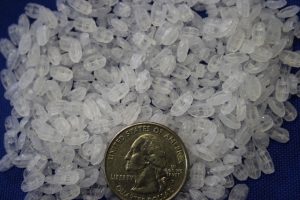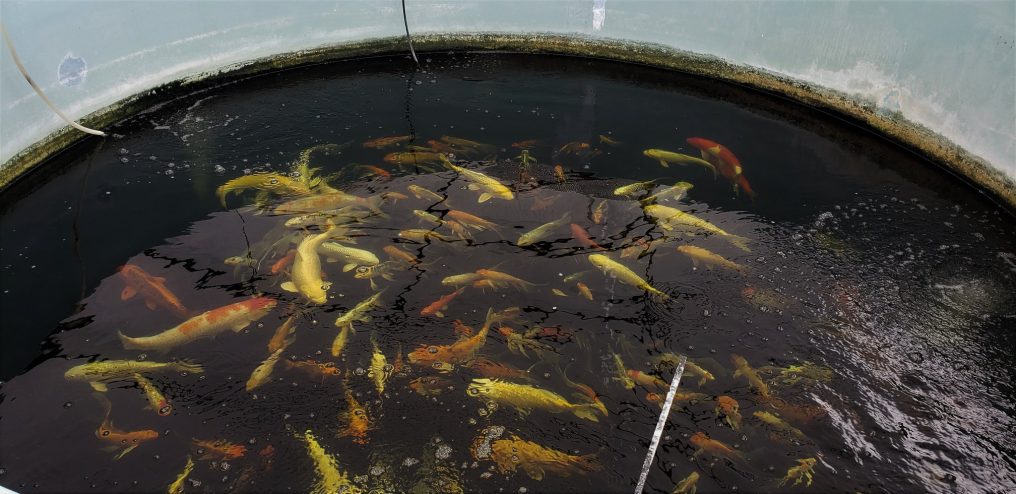This article covers ‘fishless cycling’, a method to establish a tank’s biofilter using chemicals. Fishless cycling allows the fish to flourish and eat with stable water chemistry with as little stress as possible. The major drawback is it takes several weeks to get a new system’s bacteria established before acquiring fish. New tanks with fish and no established biofilter, experience swings in ammonia and nitrite that are often deadly to the tank inhabitants. Experienced keepers test the water using water test kits, performing water changes and managing low feed rates until the bacteria are established. These fish are somewhat stressed but not to the point of death. This fine line is stressful on both the fish and keeper. If any parameter swings too far without the keeper taking action (usually a water change, or dosing the appropriate additive), the fish will die.
One benefit of running the system without fish, is the cycle can be established without risking any fish lives; we don’t have to constantly check the water quality and perform life saving measures like emergency water changes to keep them alive and happy. If you’d like the less stressful method to set up a new system and make it ready for fish, you’ve come to the right place!
Filtration Types
AST filters function as both mechanical filtration and biological filtration. A bead filter immediately performs mechanical filtration, as this is achieved by physically straining the solids out of the pond, increasing water clarity and removing fish waste directly. Biological filtration is more tricky. It takes time to establish. A bead filter provides surface area that protects and cultivates the nitrifying bacteria that break down fish waste.
There are two types of bacteria that are important in a biofilter. Ammonia oxidizing bacteria (AOBs) that develop first. This bacteria (AOBs) breaks ammonia down into nitrite. Ammonia is toxic to fish, it is their waste. Next, nitrite is still left in the water. This nitrite is also toxic to fish. The second bacteria type is Nitrite oxidizing bacteria (NOBs). These take the nitrite and break them down further into nitrates. Nitrates are not very harmful to fish, and plants use them for nourishment.

Enhanced Bead Media
Establishing the Nitrogen Cycle
This process goes faster if you manage the ideal conditions for the bacteria to reproduce.
Dose ammonia (1 mg concentration per liter).By providing the food required for the bacteria to live, these bacteria will begin breaking down the ammonia. You will see a rise in nitrite as the ammonia is broken down. Ammonia can be purchased in the detergent section of most big box stores. Only use pure ammonia without surfactants, as these in trace amounts can still harm the fish you add later. Or you can dose ammonium chloride (NH4Cl).
Dose sodium nitrite ( 1 mg per liter) This step is optional, but can save a week or two in cycling time. This is because the second bacteria (NOBs) digest only nitrite. If you are not dosing it, they must wait till the first bacteria creates enough nitrite before they can take off.
Maintain pH at 7.5-8.0
Dosing calcium carbonate or sodium bicarbonate (not ideal for aquaponics systems, water can be changed prior to adding fish) increases your alkalinity or “pH buffer”. This will allow nitrification to happen at a stable ph that is ideal for the bacteria, encouraging them to flourish. This pH is too high for aquaponics. High pH when keeping plants will result in plant nutrient deficiencies because certain minerals are not biologically available for the plants at high pH levels. This higher pH level is ideal for the bacteria getting established. Once the bacteria is established, we can lower the pH to make it more suitable for the plants. Some decoupled units are managed to provide a higher pH for the filter bacteria and a lower one for the hydroponic circulation.
Alkalinity at 120-150 mg/l
Maintaining a healthy pH buffer keeps your pH stable. A large swing in pH will kill fish and it can also knock back the bacteria cultivation process. Carbonates are consumed during the breakdown of ammonia and nitrite. If carbon isn’t present in high enough quantities, nitrification cannot happen. Tap water will have some buffers naturally present, but a fully churning biological filter processing a lot of waste will burn through alkalinity quickly. Most aquaponics systems dose some form of carbonate (potassium carbonate or calcium carbonate) regularly, such as weekly, to keep the alkalinity at a stable level. This level may be managed as lower than what is listed here, especially for plants by experienced keepers. These are the recommendations for acclimating a biofilter. If you are not running an aquaponics system, you should maintain your levels of alkalinity in this range because it is best for the biofilter.
Temperature at 77-86 degrees F The bacteria will develop well at these temperatures. Low temperatures can halve their reproduction rates, resulting in a longer wait time before the bacteria is well established.
When is a system fully cycled?
The system is fully cycled when the ammonia (TAN 1mg/l) dosed in the morning reads zero when tested at night. Nitrites may or may not be measurable. Note that some systems never show nitrites, but you know NOBs are present if you have climbing nitrates. Nitrates should be gradually climbing if there are no plants in the system. This is one of the key indicators of a functioning biofilter. Once your system is breaking down ammonia quickly all the way to nitrates, your system is safe and ready for fish. Doing a large water change with water treated to remove chlorine/chloramines, will help remove any salts or high nitrate levels brought on by the chemical dosing, giving your fish a fresh new home to move into. Remember, chlorine and chloramine are deadly not only to fish, but also to filter bacteria. Treat your water to remove chlorine and chloramine.
Happy fishkeeping!
